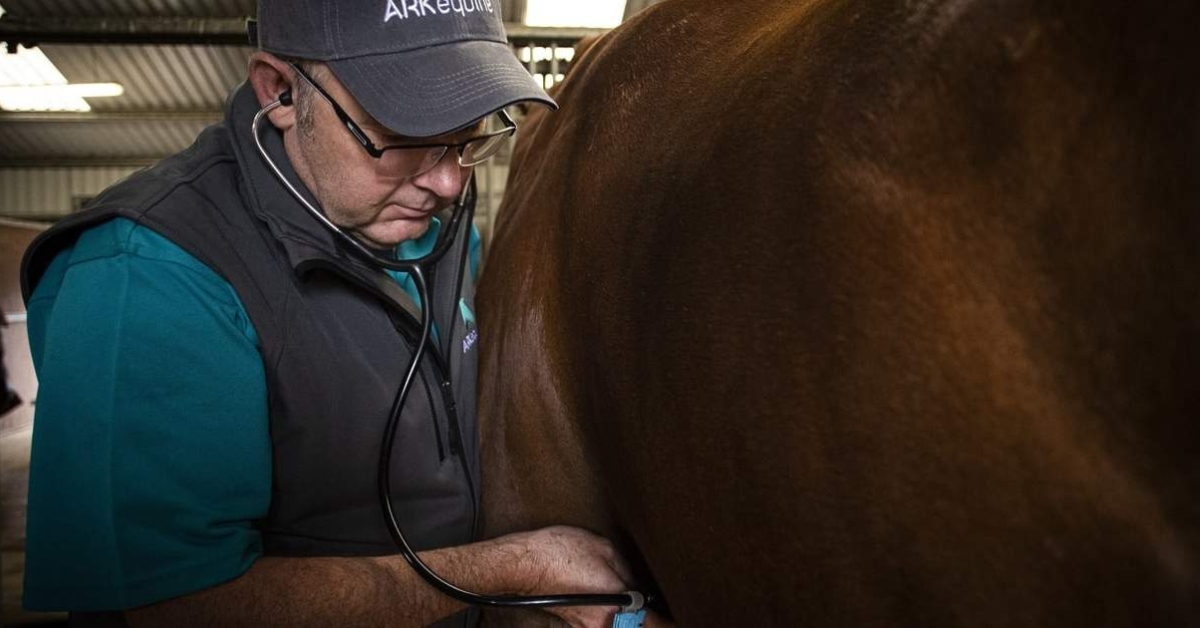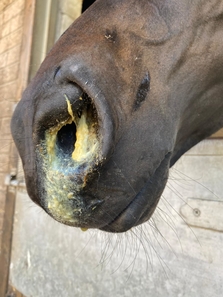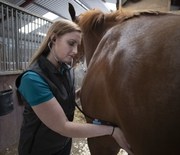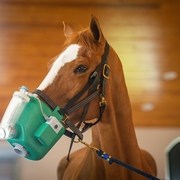
In the last article on respiratory problems of the horse we looked at the conditions caused by infectious agents such as viruses and bacteria. While infections may be what we immediately think of when a horse has a cough or a runny nose, it is just as likely that these symptoms are not caused by a bug at all but are due to a range of conditions known collectively as Equine Asthma.
Equine Asthma is an inflammatory condition. In other words, the respiratory symptoms we see are due to the small air passages in the lungs becoming inflamed without an infection being present. In this disease the inflammation is triggered by microscopic particles inhaled deep into the lungs. In an affected horse, the immune system has over-reacted to the foreign material which has reached the small air passages and has attacked the ‘invader’ by sending white blood cells to the area and increasing mucus secretion. This inflames and blocks the airway, limiting air flow and restricting the horse’s ability to get oxygen into the bloodstream. The sticky mucus and blocked airway will often elicit a cough reflex as the horse’s airways attempt to clear themselves. As we can imagine, horses suffering from any degree of Equine Asthma will not be able to perform to the best of their ability and in the worst cases may become dangerously unwell.
There are two broad categories of Equine Asthma.

This is usually seen in young horses and causes mild signs of respiratory dysfunction. Poor athletic performance is commonly noted, as is coughing which becomes a daily occurrence, particularly when first taken out to be worked. Diagnosis is obtained from endoscopic examination of the trachea which may show excess mucus being brought up from the lung. A technique called Broncho-Alveolar-Lavage, (BAL) can be employed where fluid is squirted down the endoscope and then sucked back up after it has rinsed around the small airways for a few seconds. Examination of this fluid under the microscope will show an inflammatory process is underway in these small airways if Equine Asthma is the problem. This technique (known simply as a ‘Lung Wash’) will often be part of the investigation into chronic poor-performance in an equine athlete.
Whilst this form of Equine Asthma will often require treatment, it can resolve on its own with time and may not become an ongoing issue for the horse.

This is normally seen in older horses, usually over 7 years of age. The respiratory signs are more severe, with an obvious increased breathing effort and rate. The increased use of the muscles which make the diaphragm contract gives the horse an obvious line of muscle development along the bottom of its ribcage – a ‘heaves line’- so called from the ‘heaving’ of the chest to expel the air from the inflamed lung. Coughing and a nasal discharge, (down both nostrils), are also common in these horses. Diagnosis of this severe form is not difficult. On listening to the lung sounds through a stethoscope, wheezes and crackles can usually be heard. These sounds come from the air being squeezed through narrow airways and the noise of mucus popping as the airways open on inspiration. This form of Equine Asthma will not resolve on its own and will require medical treatment and environmental management.
As the cause of the condition is an inflammatory reaction to dust particles in the environment, the primary goal will be to improve air quality. Turning the affected horse outdoors is the ideal managemental change as this is a dust-free environment. If this is not possible then the horse’s stabled environment must be optimised to reduce dust inhalation. The horse should be stabled on dust-free shavings or paper. Forage should be soaked or steamed or good quality haylage used. Hard feed should be pelleted and slightly dampened prior to feeding. Ventilation in the stable must be maximised so that the air the horse is breathing is always fresh and dust-free.

Drug treatment aims to eliminate the inflammatory reaction in the lung and to dilate the small air passages, restoring the horse’s ability to oxygenate the blood. This should return the horses breathing to normal, stopping the coughing and nasal discharge. To this end the drugs most used are steroid anti-inflammatory drugs such as dexamethasone, and bronchodilator drugs such as clenbuterol. These drugs can be given by injection or in-feed but are increasingly administered via inhalation through an equine nebuliser, delivering the medicine directly to the affected tissues.
Written by
John Henderson MRCVS
For support with good respiratory health view our recommended product:
 RESPIMIN 800G
RESPIMIN 800GUltimate respiratory health supplement
Respimin is a feed supplement designed to support the equine respiratory tract.
It is used to support horses diagnosed with respiratory conditions, and recovering from respiratory diseases such as acute, sub-acute and chronic infections (bronchitis, bronchiolitis and bronchopneumonia), viral respiratory diseases, respiratory allergies, and Recurrent Airway Obstruction (RAO). Its unique formulation encourages the release of mucous while reducing excessive coughing.
Respimin is recommended for the maintenance of a healthy respiratory tract in animals that have a history of RAO and respiratory allergies. For more on ARKequine’s Respmin click here.
ARKequine have a special promotion running across the Month of October where you can get 15% off their Respiratory product range just click the link here: Get 15% off.


Share
Your subscription is 100% Free for our first year, No credit card details required.

A pivotal meeting at the Royal Dublin Society on April 24th highlighted a significant governance crisis within Horse Sport Ireland

In the wake of recent restructuring within Horse Sport Ireland (HSI), a multitude of concerns have arisen surrounding the new

In the wake of Horse Sport Ireland’s (HSI) recent governance changes, questions and concerns have bubbled up from the grassroots